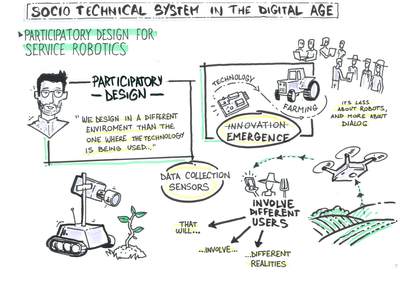Participatory design for service robotics
Valpreda, Fabrizio and Cataffo, Marco (2018) Participatory design for service robotics. In: Proceedings of RSD7, Relating Systems Thinking and Design 7, 23-26 Oct 2018, Turin, Italy.
Preview |
Text
Valpreda_Beyond_2018.pdf Download (558kB) | Preview |
Preview |
Text
Valpreda_Slides_2018.pdf Download (11MB) | Preview |
![Valpreda_MindMap_2018.jpg [thumbnail of Valpreda_MindMap_2018.jpg]](https://openresearch.ocadu.ca/2706/3.hassmallThumbnailVersion/Valpreda_MindMap_2018.jpg)  Preview |
Image
Valpreda_MindMap_2018.jpg Download (366kB) | Preview |
Abstract
The spread of technologies as Cloud and Distributed Computing, the Internet of Things (IoT) and Machine Learning techniques comes with a few paradigm changes with highly disruptive innovation potential and consequent design imperatives. Digital Abundance is a shorthand that introduces us to the economy of information as a non-depletable resource, as it can be continuously copied, while exponentially increased due to “cheap and small” sensor technology. High connectivity of devices and machines is shaping not only sensing and monitoring capabilities of different application fields, but also describing ever more ubiquitous and diffuse computing capabilities, affecting decision-making with a wide range of assisting tools and methods, like context-aware AI fuelled by a yet unmatched data flow.
On these premises, applied research at Polytechnic Interdepartmental Centre for Service Robotics in Turin, Italy, focuses on the development of a service robotics platform able to operate on the local scale and capable of adapting to evolving scenarios. Useful to this purpose is Robotics-as-a-Service (RaaS) framework, a cloud computing service model that allows to seamlessly integrate robots and embedded (IoT) devices into Web and cloud computing environment. As a service-oriented architecture (SOA) for robotic applications, a RaaS unit has the environmental potential of decoupling the production of economic value from energy and resources consumption. It includes services for performing functionalities, a service directory for discovery and publishing, and service clients for user’s direct access. This platform allows to manage robotics components both as an increasingly granular integration of control over automated tasks and as part of a largely aware whole emerging from their connectivity.
With the scaling potential of moving beyond its contemporary application such as industrial facilities monitoring, precision farming and agriculture, healthcare and risk management scenarios, RaaS is bound to involve an increasingly fluid and diverse range of users, shaping new socio-technical systems where practices, habits and relationships will evolve in respect to its adoption.
For this product-service system we propose a Socio-Technical Innovation framework to balance the efficiency of simple stable technological systems with the capacity for resilience and adaptability of more complex, unstable social systems that surround them.
Complex systems high connectivity leads to difficulties in centralized control and predicting causes and effects, driving the need of localizing decision-making when possible. Chances of identifying a single ‘optimal’ solution for the whole system width are low; great part of current information and implementation happen on a local scale, necessitating a decentralized approach. While in simple and stable systems homogeneity of input is favoured over a more problematic diversity, in complex social systems heterogeneity is incredibly more valuable, both increasing the range of current information and of solutions generated.
A wider network of stakeholders, reaching out to growing community of users and producers, allows organizations to see more opportunities than those dependent on previous choices. Local decision-making made by a variety of actors with shared interests, is likely to be the most successful: though the larger system is complex and difficult to predict, its subunits are less so. Laying our foundations on Participatory Design (PD) research we propose the Actor-network social theory as a tool to analyse the intricate relationships that define the structure of groups where humans are not the are not the only participants, as artefacts concepts and design itself function as intermediary. Thinking of stakeholders in PD as a network of actors is useful as it allows researchers or designers to understand cultural practices, power relationships and the roles of mediating artefacts or concepts, as recognizing the mechanisms through which power is exercised is vital.
In a User Experience Design context, a particularly useful term to describe possibilities of action emerging from the reciprocal relation between an actor and his environment, is affordance in its original definition proposed by psychologist J. J. Gibson in 1977. (Vardouli 2015). In his paper Vardouli argues that the notion of affordance could be analogized with the one of embedding, as they refer to possibilities for engagement of the subject with a context.
To support heterogeneity of solutions fitting diverse use cases and even different application fields we investigate service robotics case studies for modular design, to generate a product-service system of non-independent solutions.
A designed system of product components and services follows the purpose finding principle (Jones 2016). As Jones further explains in his paper on Systemic Design Principles, the purpose principle provides a whole-to-part view of problem space. The diversity of solutions provided by a modular configuration of functionalities, delivered in the form of services, guarantees a balance between fixed purposes and what Jones refers to as creative framing.
We will then explore the literature on PD solutions to usability issues. To answer interrogatives about the collection of end user requirements, about their involvement in a continuous development process and how to achieve a common understanding among the actors, we look for methods to explicitly model the interaction relationships between server and client, producer and consumer, designer and user in order to increase the learning capacity of a RaaS ecosystem through the integration of diverse experiences, while distributing means of production and innovation capacity.
| Item Type: | Conference/Workshop Item (Paper) |
|---|---|
| Uncontrolled Keywords: | System Design, Service Design, Social Entrepreneurship, Social Innovation, Sustainability, Design Democracy, Design for Well-Being, Design for Circular Economy |
| Related URLs: | |
| Date Deposited: | 25 Jun 2019 15:51 |
| Last Modified: | 20 Dec 2021 16:15 |
| URI: | https://openresearch.ocadu.ca/id/eprint/2706 |
Actions (login required)
 |
Edit View |

 Lists
Lists Lists
Lists